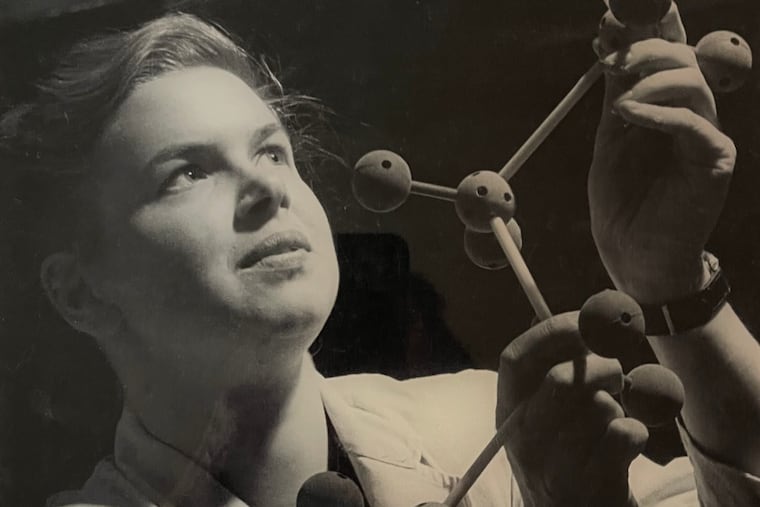Cecily Littleton, scientist, horticulturalist, and great-granddaughter of naturalist Charles Darwin, has died at 95
She studied X-ray crystallography in Philadelphia and astronomy at Haverford College, and was active with the Academy of Natural Sciences and the Buten Museum of Wedgwood.

Cecily Littleton, 95, of Haverford, a pioneering scientist who studied X-ray crystallography and astronomy, an energetic horticulturalist, and the great-granddaughter of famed 19th century English naturalist Charles Darwin, died Thursday, April 14, of cardiac and respiratory arrest at the Quadrangle retirement community.
Mrs. Littleton was part of the Darwin-Wedgwood family and a daughter of Charles Galton Darwin, a celebrated English physicist and grandson of Charles Darwin, best known as the author of On the Origin of Species and originator of the evolutionary theory of natural selection.
Her father was an authority on atomic theory and X-ray diffraction, among other things, and Mrs. Littleton studied X-ray crystallography — using X-rays to determine the atomic structure of crystals — at Somerville College at the University of Oxford with Dorothy Hodgkin, an English chemist who won the Nobel Prize for chemistry in 1964.
In her 2020 book, Dorothy Crowfoot Hodgkin: Patterns, Proteins and Peace: A Life in Science, author Georgina Ferry describes Mrs. Littleton as “a vivacious Sommerville student” who worked closely with Hodgkin.
In the early 1950s, Mrs. Littleton was a research fellow with noted X-ray crystallographer Arthur Lindo Patterson in the department of physics at Philadelphia’s Institute of Cancer Research, now Fox Chase Cancer Center. Along with Raymond Pepinsky, a physicist at Pennsylvania State University, and others, the ICR scientists made significant advances in the statistical approach to X-ray analysis and the modeling of crystals.
In 1953, Mrs. Littleton published a paper in the scientific journal Acta Crystallographica entitled “A structure determination of the gluconate ion” that described her research. “Though the crystals of sodium and potassium gluconates showed very different habits,” she wrote in the analysis, “their stereographic projections had some similarities.”
In the 1960s, Mrs. Littleton joined astronomer Louis C. Green at Haverford College. Using new but rudimentary computers to refine their research, Mrs. Littleton, Green, and his team, many of whom were young women scientists, studied stellar evolution, the internal structure of stars, and other cosmic activity.
At night, Mrs. Littleton would spread her pencil-marked graph paper across the dining room table and, using her old slide rule, run through her celestial calculations. She had a “wide-ranging curiosity, keen observation, and scientifically trained mind,” her family said in a tribute.
In the 1980s, Mrs. Littleton completed the horticulture certificate program at the Barnes Foundation and helped design landscapes at Station Road Park in Wynnewood and the old Episcopal Academy campus in Merion, now part of St. Joseph’s University.
Cecily Darwin was born in Edinburgh, Scotland, Nov. 15, 1926. Her father’s mother was Martha “Maud” Darwin, of the DuPuy family of Philadelphia, and Mrs. Littleton grew up in Edinburgh and England.
She graduated from Somerville in 1949 and, along with Hodgkin, published a 1950 article in the journal Nature that described how they found new ways to examine the structure of biomolecules.
Mrs. Littleton moved to Philadelphia after college to work at the Institute of Cancer Research and met lawyer and musician John E. Littleton at a New Year’s Eve party. They married in 1951, had daughters Joanna and Sophie and sons Francis and Charles, and lived in Wynnewood.
Curious, engaging, and well read, Mrs. Littleton liked to garden, take nature walks, and host gatherings of family and friends. She was a member of All Saints’ Church in Wynnewood and active in many organizations, including the Academy of Natural Sciences, Pennsylvania Horticultural Society, and Buten Museum of Wedgwood.
On Nov. 2, 1989, on Darwin Day at the Academy of Natural Sciences, Mrs. Littleton donated a chair that had belonged to her great-grandfather that the academy displays in its rare books room.
An adventurer, she sailed through the narrow Beagle Channel in South America on her way to the Galapagos Islands, toured China in the 1990s, and kept voluminous scrapbooks of her many travels.
She and her husband moved to the Quadrangle in Haverford in 2002 and joined St. George’s Episcopal Church in Ardmore. He died in 2009.
“She was devoted to her children and encouraged us to find ourselves,” said her daughter, Sophie.
In addition to her children, Mrs. Littleton is survived by seven grandchildren, one great-granddaughter, and other relatives. Four brothers died earlier.
A funeral service is to be at 11 a.m. Saturday, July 16, at St. George’s Church, 1 W. Ardmore Ave., Ardmore, Pa. 19003.
Donations in her name may be made to the Academy of Natural Sciences Library and Archives, 1900 Benjamin Franklin Parkway, Attn: IA, Philadelphia, Pa. 19103.